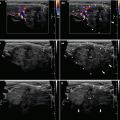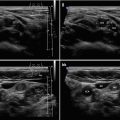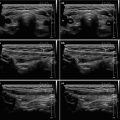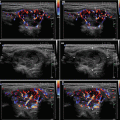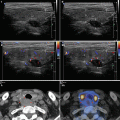and Zdeněk Fryšák1
(1)
Department of Internal Medicine III – Nephrology, Rheumatology and Endocrinology, Faculty of Medicine and Dentistry, Palacky University Olomouc and University Hospital Olomouc, Olomouc, Czech Republic
Keywords
Thyroid abscessBroad-spectrum antibioticsFine-needle aspiration biopsyStrict aseptic measures25.1 Essential Facts
Acute thyroiditis with abscess formation is an extremely rare condition with a rapid (usually several days), possibly dramatic and life-threatening course (several hours).
Clinical presentation:
General symptoms—fever, chills.
Local manifestations—classical signs of inflammation: heat, pain, redness and swelling—firm induration over the affected thyroid lobe, painful on palpation, erythema over the mass.
Suddenly formed large abscess leads to tracheal deviation and compression and may cause severe dyspnea requiring intubation and emergency surgical treatment.
Symptoms: pain on palpation or persistent pain at the site of the mass, limited neck movement, difficulty swallowing, dyspnea and dysphonia, even inspiratory stridor in case of dramatic course [1].
Most common causes of abscess formation according to patient age:
In children, abscess is usually formed in the setting of the normal thyroid gland due to spread of infection by pathological communication in congenital abnormalities of the oropharynx-fistula of processus piriformis or persistent thyroglossal duct [2].
In adults, abscess is usually formed in the setting of multinodular goiter:
In immunocompromised patients, by haematogenous spread of infection in sepsis from another primary source (the gastrointestinal or genitourinary tracts) [3].
Mechanical insult—swallowing of sharp foreign body (e.g. a bone) and subsequent perforation through the esophageal wall [4], or iatrogenic causes (after fine-needle aspiration biopsy) [5, 6].
Most common infectious agents: skin pathogens—Staphylococcus aureus, Streptococcus pyogenes, pathogens of the gastrointestinal and genitourinary tracts—Escherichia coli, Pseudomonas spp. [9, 10].
Treatment: broad-spectrum antibiotics, excision and drainage of the abscess, thyroidectomy is sometimes necessary, with removal of the surrounding soft tissues infiltrated with inflammation [1].
25.2 The Case Report [11]
80-year-old female patient with a long history of large multinodular goiter of 38 mL followed-up by ultrasound.
Personal history: cholecystectomy many years ago, no history of diabetes mellitus, no immunity influencing drugs.
At a local radiology center, US-FNAB from the right lobe was performed, with benign cytology results.
Three days after the FNAB, painful mass suddenly formed at the right neck site of puncture.
Over the next days, the mass enlarged, with increasing pain and local erythema development (Fig. 25.1). Patient suffered from increased body temperature of 37.0 °C, dysphagia, dyspnea, and later stridor.
Eight days after the FNAB, patient was examined in outpatient endocrinology center of university hospital:
US (Figs. 25.2 and 25.3) and computed tomography findings (Fig. 25.4) demonstrated a large abscess in the right thyroid lobe, with a volume of 60 mL, causing tracheal deviation and compression.
Stay updated, free articles. Join our Telegram channel

Full access? Get Clinical Tree



